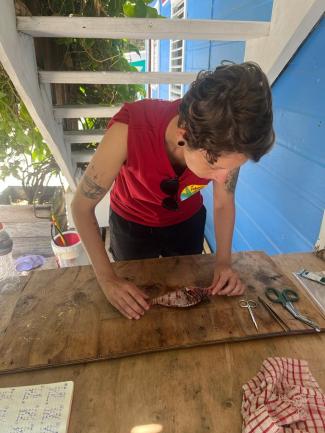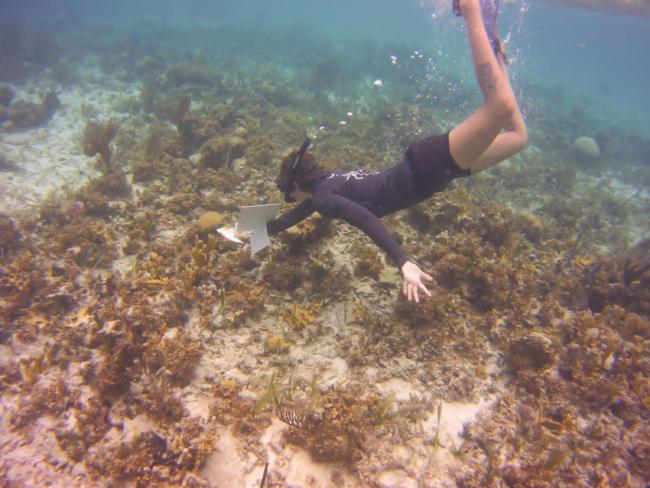What it’s like doing research on a coral reef
Receiving the Queen Elizabeth II Scholarship Award this past year was an honour that allowed me to live the experience of a lifetime and fulfill a dream that I otherwise would not have been able to.
Along with other scholars, I picked a Commonwealth country where I could focus on the theme of Bringing Resilience to Coastal Communities (BRiCC). I chose Belize, in Central America, for a variety of reasons. Besides being a coastal country, it is home to the second biggest coral reef in the world (after the Great Barrier Reef in Australia) and being located in the equator, I knew its biodiversity would be astounding. As a third-year Biology student with a minor in Fisheries and Aquaculture, my main goal was to work with animals in the marine environment and learn as much as possible!
My arrival and first impressions
My summer internship took place at the Tobacco Caye Marine Station, located on the tiny island of Tobacco Caye. The Tobacco Caye Marine Station is a non-profit organization that is committed to protecting the environment, as well as educating people about marine life in Belize. My first big surprise was seeing the amount of coral fragments on the beach! They are virtually everywhere, with different and intricate patterns on their carbon “skeleton.”

My internship was absolutely incredible, full of challenges (as life-changing experiences are) and brand new information that expanded my perspective in many ways. For example, the island of Tobacco Caye is currently about four acres in size – I was able to go for a walk around the island in about 10 minutes – but it was once six acres. The majestic mangrove roots that bordered the island were removed by humans to create a beautiful view of the ocean from the windows. However, they failed to recognize that the mangrove has very important ecological roles, including providing the island with protection from incoming harsh waves during storms, which help prevent erosion. A big challenge for me was the Equatorian heat and what seemed like the hungriest mosquitoes I have ever encountered.
My first research project: lionfish

I worked on three research projects: lionfish dissection, coral watch for bleaching signs and trash repurposing. I was excited to have more experience with dissections! The lionfish (Pterois sp.) is a venomous invasive species in the Caribbean (meaning they are not originally from there) and has brought great unbalance to the reef ecosystem. They were introduced by humans through the pet trade (as they are gorgeous-looking fish). However, being the very efficient predators that they are, they eat all of their aquarium “roommates” and can grow to more than one foot long in size. The combination of these two characteristics made those who owned them as pets quite unhappy, and as a result they were discarded into the ocean. Other factors that make them invasive include the fact the that lionfish don’t have any natural predators in the Caribbean, can live up to 30 years old and the females can lay 50,000 eggs per week. Yes, you read that right. The marine station promotes the culling of lionfish to locals and pays them by the pound, giving them extra income, as earning a living can be quite burdensome when you live in such a small island. The fish are then dissected and data is collected. We noted things like the size, weight, gender and the contents of their stomachs. The station has found more than 40 different species of animals inside their stomachs, further proving the threat they pose to the reef ecosystem. After removing the 18 venomous spines, lionfish are safe to eat – and delicious!
My second research project: Coral Watch

The second research project (Coral Watch) had us interns compare a colour-coded chart to the corals themselves and note their colour shades, which could indicate bleaching, as well as the type of coral. It was incredible to experience with my own eyes the difference in bleaching stages from different sites, and how biodiversity is directly connected to the health of corals. I was personally not the greatest swimmer and the progress I made was so rewarding! From learning to breathe slowly when snorkeling for the first time to being able to dive and collect data on the corals! Corals are animals (from the phylum Cnidaria – a cousin of the jellyfish) and have a colourful “friend” living inside them (a symbiotic relationship with a microscopic organism, where they both help and benefit from each other). Corals are very sensitive to environmental changes, living in a “goldilocks zone,” as my manager liked to put it. If changes in temperature, light availability and pH occurs, it causes the coral to eject their colourful “friend,” losing their beautiful colours and becoming weaker and vulnerable in the process. This means that when a coral is bleached, it isn’t dead (and there may still be a chance of recovery). Coral bleaching is caused by a variety of reasons, most of them connected to climate change.
However, there is one way that humans can do their part. All the sunscreen we used had to be certified REEF SAFE and this designation is something the public can look for on sun protection products that are available in regular retail stores.
My third research project: trash collection and repurposing
My last research project focused on the collection of marine debris, sorting, cleaning, but most importantly: re-purposing. We often received bags of garbage from well-meaning tourists that collected garbage around the island. It is important to note that this was just the FIRST step of the process. The data on the debris collected by us and students is uploaded to the National Geographic Marine Debris Tracker App and all soft plastic is re-purposed into “ecobricks.”

A mix of old skills and new
My personal and unique contributions to the marine station involved the combination of a new passion and an old one of mine: I was able to put my graphic design background into good use and produced postcards for an upcoming project. My most recent passion is related to plankton. I worked on a plankton ID chart for the station, with photos taken by me while I analyzed samples collected around Tobacco Caye.
This international internship experience has certainly solidified my choice of becoming a marine biologist in the future. If you’re interested in an international experience as a student, the next QES Application deadline is November 28, 2022!




